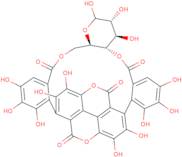
Produktinformation
- 2,20,1,23-(Epoxy[2]propene[1,2]diyl[3]ylidene)-11H,15H-tribenzo[g,i,q][1,5,12]trioxacyclononadecin, <span class="text-smallcaps">D</span>-glucose deriv.
- 3,4,5,11,12,13,21,22,23,26,27,38,39-Tridecahydroxy-9,14,17,29,36-Pentaoxaoctacyclo[29.8.0.02,7
- <span class="text-smallcaps">D</span>-Glucose, cyclic 4,6-[(2S,2′S)-2,2′-(5,10-dihydro-2,3,7,8-tetrahydroxy-5,10-dioxo[1]benzopyrano[5,4,3-cde][1]benzopyran-1,6-diyl)bis[3,4,5-trihydroxybenzoate]]
- [1]Benzopyrano[5,4,3-cde][1]benzopyran, <span class="text-smallcaps">D</span>-glucose deriv.
Punicalin is a natural product that has been shown to be a potent anti-inflammatory agent. It has been shown to inhibit the production of cyclin D2, which is associated with the development of atherosclerotic lesions. Punicalin also induces autophagy and inhibits oxidative injury in mouse tumor cells. Punicalin has been shown to have antibacterial efficacy against gram-positive bacteria (e.g., Bacillus subtilis) and gram-negative bacteria (e.g., Escherichia coli). It can also be used for the treatment of infectious diseases such as tuberculosis or bacterial sepsis, which are characterized by high levels of oxidative stress. Punicalin has been shown to have a number of physiological effects, including an increase in liver glycogen content and blood sugar levels, as well as inhibiting gsh-px activities in rat liver cells.
Chemische Eigenschaften
Technische Anfrage zu: 3D-FP74109 Punicalin
Wenn Sie ein Angebot anfordern oder eine Bestellung aufgeben möchten, legen Sie stattdessen die gewünschten Produkte in Ihren Warenkorb und fordern Sie dann ein Angebot oder eine Bestellung an aus dem Warenkorb. Es ist schneller, billiger und Sie können von den verfügbaren Rabatten und anderen Vorteilen profitieren.





